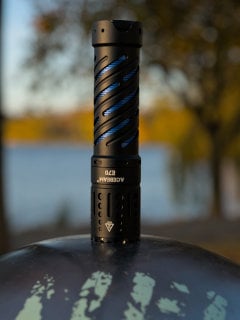

If you’re new to Anduril, you might find my diagrams useful. https://lemmy.world/post/1038159 The TS10 is a great little light, and can be easily updated since the driver has flashing pads.


If you’re new to Anduril, you might find my diagrams useful. https://lemmy.world/post/1038159 The TS10 is a great little light, and can be easily updated since the driver has flashing pads.
Thanks. I finally made the updates.


This is an awesome mod. The time and effort and skill that goes into something like this is really impressive.
Yeah, I’m thinking it has the wrong emitters. I figured that Jackson would take care of it.


Thanks for this feedback. Sync still isn’t converting the dashes to bullets, but at least I got the line breaks to show up now. I guess the web interface is more forgiving than Sync.


Yeah, I just noticed that Sync on Android butchered my bullet lists. I wonder if that can be resolved?
I think that all of us who are already here just need to start posting more content (myself included), and that will draw more people in. Lemmy is now the home of my Anduril 2 diagrams, but I also need to update and port over some of my old posts from Reddit because some of you may get some use out of them. The more we post, the more information we have available, and that has enormous value. I personally love to see mod posts. @Adair21@lemmy.world is one of the most gifted modders out there, and he shares his mods and builds here. It’s absolutely incredible the sort cool stuff folks are doing to their lights. It’s also great to see “measurement” posts where folks share the results of testing out different emitters (CCT, CRI, lumens, etc.), cells, optics, entire lights, etc. That’s all extremely useful information for the rest of us. And let’s not forget about good old fashioned New Light Day (NLD) posts where folks simply share info about their latest haul. It’s fun to chime in on those, and share your own experiences and mods for those lights. The bottom line is that the content doesn’t magically show up for us. We have to create it ourselves.
Yeah, there are a couple of things I’m working on (very slowly):
It’s a slow process because I’m using Inkscape for the first time and I’ve just been busy. But any updates will always be posted here.


18350 is my favorite format as well. Too bad there isn’t something like a 21400 format.


Yeah, possibly if I can find a way to squeeze it in. Can you confirm which mode lack thermal regulation? I think it’s more than just candle mode. Does it apply to all of the blinkies? For some reason, I thought this was fixed in a later version.


Flawless work as always.
It’s awesome to see so many familiar folks over here. So glad this community is growing.
This is going to sound silly, but I didn’t realize that I could post in-line images. I added both per your suggestion, and it’s much more functional. Thanks for getting me to finally look into it!
Yes, maybe if I had Adobe Acrobat Professional, I might be able to produce high-quality PDFs. But the cost is insane, and I just haven’t had a need for it. Perhaps I’ll have better results if I can ever get the diagrams switched over to an open-source alternative for Visio.


It appears in the diagram because it works. Just tested it again on my dual-channel D4V2, and it works like a charm.
That’s an awesome reference website! Thanks for sharing.
I originally saved the file as a PDF in Visio, and as you noted, the results were not good. Then I tried printing it to PDF in a couple of different ways, and I think the result is much better. Take a look at it again, and let me know what you think. The Simple UI diagram will always be smaller because that’s how the source is. When Visio saves it to a PNG file, it chops it down to just the canvas size needed for the diagram. Then when you print it, it gets enlarged to cover the whole page.
It looks like you can install avrdude on a Mac via Mac Ports.
I don’t have a D2, but I assume that it uses a T1634 just like a D4V2. I believe that pymcuprog is for UDPI programmers, and your Hank programmer is USBasp which requires avrdude for programming. I realize that this post is for Windows, but it covers command-line usage of avrdude. It might help. I’m kind of shocked that I don’t already have this documented somewhere, but I’ve been using zFlasher on Android for quite a while. It can handle UDPI and USBasp programmers.
As a side note, I believe that Hank uses a custom version of Anduril 2 for his lights. For example, I think that he exposes more of the “advanced” features in the Simple UI than ToyKeeper does. Of course, that’s the beauty of open-source software. You can customize it. In any case, my point is that you can keep current with Anduril 2 while also customizing it for your preferences if you’re willing to learn to modify the code. I’ve gotten to the point where I just stick with stock Anduril 2 in most cases.
deleted by creator